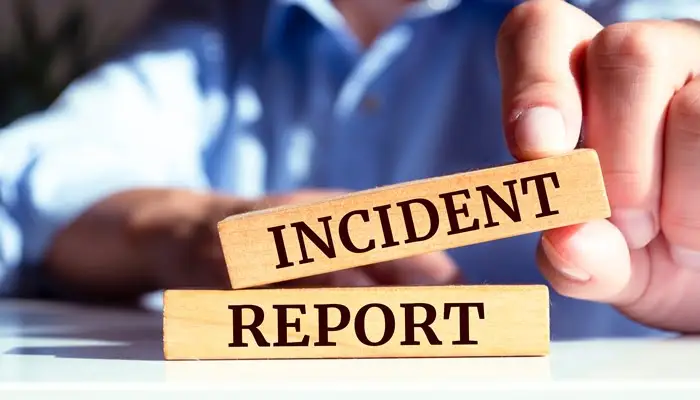Summary: It is crucial to have a grasp of writing incident reports to ensure a healthy workplace environment. By familiarizing yourself with the elements of an incident report following an approach and adopting practices you can create precise and impactful reports. Remember to record all details maintain objectivity and transparency in your descriptions and prioritize promptness. Incident reports also serve as resources, for incidents enabling organizations to detect trends address underlying issues, and implement preventive measures.
Utilizing templates for incident reports can help streamline the reporting process and maintain consistency across reports. These templates offer a layout encompassing sections, like basic details, incident descriptions, actions taken, and preventive measures. They save time. Ensure capture of essential information.
Understanding Incident Reports
What is an Incident Report?
An incident report is a document that provides an account of an incident or accident that occurred. It acts as a record that outlines what transpired during the event. Incident reports play a role in settings such as workplaces, public safety agencies, and organizations where reporting incidents is essential, for liability purposes, risk management, and maintaining a safe environment.
Reporting incidents properly can also aid in spotting trends and areas that need improvement. By recording incidents thoroughly organizations can take steps to prevent occurrences in the future. Equally significant is the disclosure of any confidential information.
Significance of Incident Reports
Incident reports are essential, for ensuring the safety and well-being of individuals in any environment. They provide a record of what took place during an incident allowing stakeholders to comprehend the situation and take action. Moreover, incident reports serve as resources for identifying patterns, potential risks, and areas for enhancement in the future. Additionally, incident reports may be necessary for matters, insurance claims, or internal investigations.
Key Components of an Incident Report
- A typical incident report comprises the following elements; Date and Time; The precise date and time when the incident occurred should be documented to establish a sequence.
- Description of Incident; A narrative outlining what transpired during the incident including specifics, about the location, environmental conditions, and other relevant information.
- Individuals Involved; The names and roles of individuals directly or indirectly connected to the incident should be noted down.
- Injuries or Damages; Any injuries or damages resulting from the incident should be described in detail within the report.
- Witness Testimonies; Testimonies, from individuals who witnessed the event can offer viewpoints and valuable insights.
- Immediate Response Taken; Any immediate actions carried out after the event like providing medical aid or contacting emergency services need to be documented.
- Analysis of the Root Cause; Pinpointing the cause of the incident is crucial to prevent occurrences in the future. This examination should be included in the report.
- Remedial Actions; Document the steps or actions implemented to resolve the incident and avoid its repetition.
- Follow-Up Measures; Outline any measures taken, such as training or changes in protocols within the report.
Elements of an Incident Report
To craft an incident report specific elements must be incorporated to present a comprehensive overview of what transpired.
Essential Details
The incident report must encompass details concerning when and where the incident occurred well as those individuals involved. This section establishes context. Lays a groundwork, for the report.
Narrative of Events
This segment delves into narrating what transpired during the event itself.
Provide an account of the event detailing the sequence of occurrences, environmental conditions, and any contributing factors. The description should be unbiased based on facts and devoid of opinions or assumptions.
Steps Taken
Detail the actions carried out immediately following the incident, in this section. This may involve administering aid contacting emergency services or implementing safety precautions. Document these steps to maintain a timeline.
Preventative Actions
To prevent incidents in the future it’s crucial to include a section on measures. This could encompass suggestions for enhancements, modifications to protocols or procedures, or additional training needs. Organizations can enhance safety by addressing causes and instituting preventive actions.
Writing an Incident Report
Creating an incident report may appear overwhelming initially. However, by following an approach, you can ensure all essential details are included while maintaining accuracy and clarity. Here’s a straightforward guide to assist you through the process;
Collect Information; Gather all information about the incident such, as time, date, location, and individuals involved. It is crucial to have detailed information to create a report.
Begin with Basic Details; Start the report by introducing information, like the title “Incident Report,” along with the date, time, and location of the incident. This sets the context for the report.
Offer a Clear Account; Clearly and succinctly describe the incident focusing on the sequence of events and any factors that contributed to it. Utilize details while avoiding assumptions or personal opinions.
Incorporate Witness Testimonies; If there were witnesses during the incident include their statements in the report. Their observations and testimonies can offer perspectives. Bolster the accuracy of the report.
Document Response Actions; Detail the actions taken following the incident. This encompasses providing aid contacting authorities or implementing safety measures. Ensure to mention individuals involved in these actions by name.
Pinpointing Root Cause; Investigate the incident to determine its root cause. This entails examining circumstances and any contributing factors involved. By identifying this root cause you can establish measures to prevent incidents from occurring.
Suggest Preventive Actions; Drawing from the root cause analysis propose recommendations for actions. These suggestions may include changes, in protocols additional training initiatives, or implementation of safety protocols.

Drive EHS excellence digitally
- Inspections & Audits
- Safety & Compliance
- Risk assessment
- Corrective Actions & Reporting
Ensure that you are clear and specific, in your suggestions
Review and Edit; Before finalizing the report go through it to check for accuracy, clarity, and completeness. Make sure all necessary information is included and that the report aligns with the organization’s reporting standards.
Get Approval and Share; Once the report has been. Edited, seek approval from the authority. Once approved share the report with stakeholders like managers, safety personnel, or HR departments.
Using Templates for Incident Reports
To streamline the writing process consider using incident report templates. These pre-made forms provide a framework for documenting incidents. Ensure that all crucial details are captured. Incident report templates come in formats such as PDF or online forms. Typically include sections like basic information, incident description actions taken, and preventive measures. Templates can help save time and maintain consistency across reports.
The Significance of Incident Reports
Legal Implications
One reason why incident reports are important is due, to their legal and liability implications. Documenting incidents can safeguard both the company’s interests well as those of employees. In case of actions or insurance claims a documented incident report can serve as evidence providing a clear record of what occurred. Creating a Healthy Work Environment
It’s crucial to report incidents accurately to promote a safe and healthy work environment. By doing employers can pinpoint risks and proactively prevent similar occurrences. Incident reports are essential, for risk management. Ensuring that necessary steps are taken to uphold workplace safety.
Best Practices for Writing Incident Reports
To enhance the quality and utility of incident reports it’s important to adhere to practices. Here are key guidelines to follow;
Accuracy and Objectivity
Maintain accuracy and objectivity throughout the report by sticking to information. Avoid assumptions or personal opinions instead focus on details with supporting evidence.
Clarity and Brevity
Use language when conveying information in the report. Steer clear of jargon that may not be easily understood by all readers opting for sentences to make the report accessible across a broad audience.
Timeliness
Submit incident reports promptly after an event occurs to capture details. Timeliness is critical, for ensuring appropriate actions are taken swiftly as delayed reporting may result in missing information or a precise account of the incident.
Detailed Description
Provide an account of the incident outlining the series of events, environmental circumstances, and any factors that played a role. It is important to include details to give stakeholders an understanding of what happened. This detailed information can help in recognizing any patterns or potential risks.
Identifying the Root Cause
Conduct an investigation, into the incident to pinpoint its root cause. Understanding why the incident took place allows organizations to implement targeted measures. Delve deeper into factors like equipment malfunctions, human mistakes, or environmental dangers that may have contributed to the incident.
Stakeholder Involvement
Engage stakeholders, in the reporting process of the incident. This could involve supervisors, safety officers, HR personnel, or legal representatives. Their insights and expertise can enhance the accuracy and completeness of the report.
FAQ | Incident Report
What is an incident report?
An incident report is a document that records details about an unexpected event, accident, or problem that occurs within an organization. It documents the incident for analysis, investigation, and future reference.
Why is incident report writing important?
Incident report writing is crucial for maintaining transparency, accountability, and safety within an organization. It helps identify root causes, implement corrective measures, and prevent similar incidents in the future.
What should be included in an incident report?
Quality management software provides tools for effectively managing quality processes, ensuring compliance with standards, analyzing data for improvements, and enhancing overall quality control and quality management.
What are the best practices for writing an incident report?
Best practices for incident report writing include being objective and factual, using clear and concise language, avoiding speculation or assumptions, documenting information promptly, and following established reporting procedures or templates.
Are there any templates available for incident report writing?
Yes, various templates are available online or provided by organizations to standardize the format and content of incident reports. These templates often include sections for capturing essential information and can be customized to suit specific needs.
Who should be involved in incident report writing?
Depending on the severity and nature of the incident, individuals involved in incident report writing may include frontline employees, supervisors, safety officers, human resources personnel, and legal representatives. Collaboration among relevant stakeholders ensures comprehensive documentation and analysis.
How can incident report writing contribute to organizational improvement?
Effective incident report writing enables organizations to identify trends, assess risks, and implement preventive measures to enhance workplace safety, operational efficiency, and overall performance. Organizations can continuously improve their processes and procedures by learning from past incidents.
Image: Adobe Stock – Copyright: © Uuganbayar – stock.adobe.com







